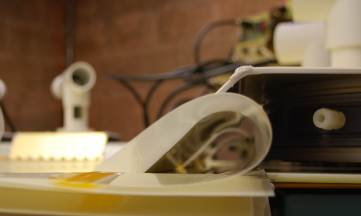
Insulator breakdown causes discovered, reinforcement started
Reinforcement will be completed in June for planned firing with 12 switches up to 45 kV in July
LPP’s research team, with the able help of LPP consulting scientist John Thompson, has unraveled the likely cause of the insulator breakdown we experienced when firing one capacitor at 45 kV. To understand the sequence of events, it should be noted that the top layer of the Mylar insulator is turned back to form a roll that is taped back on itself; the image below shows this curl, prior to taping, during FF-1’s original assembly in Fall 2009. This geometry is meant to eliminate a straight surface breakdown path from the aluminum plate to the switches. During just the few instances of single capacitor firing, the asymmetric current created much more vibration on the top plates than usual. In addition, the plates were not stabilized and held down by the transition plates which were normally attached to the switches. The vibration loosened the tape, allowing the Mylar to unroll, apparently touching the switches.
Once this happened, a path was opened up for the current, which we traced by the damage done. The current jumped through the short distance from the underside of the switches to the unrolled Mylar, across that surface to the end of the main Mylar stack. It then broke through a single layer of the Mylar, ran a fraction of an inch along it and then jumped down to the ground plate through an air gap between the ends of the Mylar layers and a piece of heavy plastic that is on top of the capacitors. This air gap was supposed to be filled with an adhesive insulator called RTV, but unfortunately the adhesive did not have sufficient hold on the ends of the Mylar sheets to prevent an air gap.
While the breakdown most probably would not have occurred except under the unique conditions of testing a single switch, we are reinforcing any and all potential weak points that could remain even with symmetrical firing of the entire bank, to ensure reliable operation of all twelve capacitors at 45 kV. First, as Dr. Thompson recommended, the Mylar stack will be sealed under the lip of the plastic (G10) with a wide layer of adhesive on the top of the stack, rather than having the stack butted against the adhesive. Second the taping of the Mylar roll will be altered to relieve stress on the Mylar and make unrolling far more unlikely. Third, more lead weights will be added to hold down the aluminum plates and prevent vibration. And finally, on Dr. Subramanian’s suggestion, the underside of the switches will be protected with an insulating cover, probably of Mylar, so that no direct sparks can originate there.
We hope to achieve the full upgrade of the device, including installation and testing of all 12 new switches, during June and resume firing in July. (This is dependent on our suppliers keeping to their delivery promises!)
For more info, contact LPP directly.
